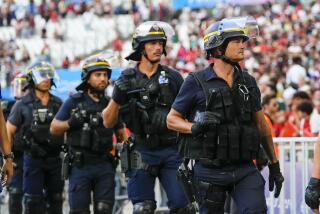Trial Opens in Alleged Airline Bomb Plot
- Share via
NEW YORK — Prosecutors charged Wednesday that Ramzi Ahmed Yousef and two co-defendants planned to kill 4,000 people aboard 12 jumbo jets over the Pacific Ocean in two days of terror early last year.
On the opening day of a trial expected to last three months, federal attorneys said they would prove that the defendants were plotting the bombings to punish the United States for its support of Israel.
Yousef, 28, also faces a charge in a trial scheduled for later this year of masterminding the 1993 World Trade Center explosion that killed six people and injured more than 1,000.
Prosecutors said the sophisticated bombs planned for the airliners were designed to pass unrecognized through airport metal detectors. One of the bombs was tested on a Philippine Airlines flight bound for Tokyo in December 1994, killing a Japanese businessman.
Only a fire, started when bomb-making materials were carelessly mixed in an apartment in Manila, prevented the airline carnage.
Government lawyers said Yousef fled to Pakistan after the fire. He was tracked down and arrested, prosecutors claim, as he was stuffing explosives into baby toys for further attacks on U.S. air carriers.
They also charged that Yousef had threatened to poison Manila’s water supply unless one of his arrested co-defendants was released.
Prosecutors told the jury of seven men and five women that there was extensive physical evidence--including fingerprints, phone records and explosives--that would implicate Yousef and co-defendants Abdul Hakim Murad and Wali Khan Amin Shah.
They added that Yousef and Murad had confessed details of the plot to FBI agents after they were arrested.
“Thousands of passengers would have died . . . only because they happened to be on a particular flight on a particular day,” charged Assistant U.S. Atty. Michael J. Garcia.
“These defendants wanted to punish American civilians until the U.S. changed its foreign policy towards Israel. . . . These defendants had this plan worked out to the minute,” the prosecutor added as Yousef, dressed in a black suit, sat quietly, sometimes smiling. “These defendants wanted to hold Americans responsible for the actions of their government.”
Later, Yousef startled the court by asking through attorney Roy Kulcsar that he be allowed to deliver his own opening statement to the jury.
Obviously displeased, Judge Kevin T. Duffy said Yousef would be acting as his own lawyer and risked jeopardizing his entire defense.
The judge sternly lectured Yousef about the possible consequences of convicting himself and making “the most unwise decision of your life.” He asked Yousef about legal terms and the potential consequences of the charges he faces.
”. . . Asking a question is permitted, but not giving a statement,” Yousef replied.
Duffy said he would respond today to Yousef’s request.
Garcia told the jury that Yousef’s computer, which was recovered after the Jan. 6, 1995, fire in the Manila apartment, outlined plans to bomb Delta, Northwest and United Airlines flights to Los Angeles, San Francisco, Honolulu and New York.
He charged that a test bomb was detonated in the Greenbelt Theater in Manila on Dec. 1, 1994, and 10 days later Yousef exploded another bomb with a timing device aboard a Philippine Airlines flight to Tokyo, killing Haruki Ikegami, a passenger, and injuring several others. The pilot, who managed to make an emergency landing in Okinawa, is scheduled to be among the witnesses in the trial.
More to Read
Sign up for Essential California
The most important California stories and recommendations in your inbox every morning.
You may occasionally receive promotional content from the Los Angeles Times.













